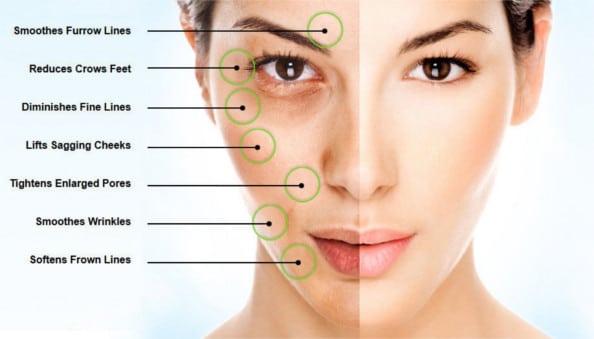Hyaluronic acid is an up and coming ingredient in skin care that naturally contains a wide host of benefits to support beauty and skin health. It’s used in a variety of products such as creams, injectables, supplements and serums.
Hyaluronic acid is referred to as a glycosaminoglycan which simply put, means that it’s a vital substance that the body produces naturally. It’s produced by fibroblast skin cells that decline as we age. The average person has approximately 15 grams of natural hyaluronic acid with about one-third to one half (30%-50%) synthesized each day. It’s used by the body for locking in moisture to keep the skin youthful, soft and smooth. As well as this, it supports the joints with structural support and protects against microorganisms.
Skin
When we grow older, our skin gradually begins to lose moisture which can give the appearance of looseness and age. The production of this important acid initially begins to decline in our 20s, but this process is then accelerated as we reach our 40s. As Hyaluronic acid improves the body’s ability to hold onto water, supplementing with it can help to reduce the effects of aging. Research has shown that additional Hyaluronic Acid can increase skin moisture and smoothness whilst removing or decreasing wrinkles. Per gram (0.03 ounce) of hyaluronic acid, your skin can hold 1000ml of water on average. It also stops any pollutants, dirt or grime from entering the skin which can cause spots and other nasty effects.
Hyaluronic acid can even adjust how much moisture it absorbs dependent on the humidity and climate of your surrounding environment. Just as too little water is detrimental for your skin, so is too much. The ability that this acid has to self-adjust is invaluable in the battle against aging. Hyaluronic acid both improves the moisture kept in your skin while also improving your skin’s outer layers for a smoother appearance almost instantly. It even provides antioxidants for defence against your surrounding environment.
As well as improving moisture absorption, Hyaluronic acid protects the skin from UVB rays – the rays which cause burns and sunspots. We all know how damaging the sun can be for our skin, so using hyaluronic acid can combat these negative effects.
Lastly, hyaluronic acid is used in various moisturizing and make-up products due to its anti-inflammatory properties.
Joints
Hyaluronic acid is a polysaccharide that can help support the joints by strengthening the surrounding cartilage, improving their ability to resist compression and providing lubrication. This also reduces the chances of osteoarthritis.
You’ll find hyaluronic acid in connective tissue and eye fluid. Though, just under 50% of it is found in the skin.
Reliability
There are many different products in the health and beauty industry that all promise to improve the vitality and youthfulness of your skin. Though, hyaluronic acid is thought to be an extremely safe and effective ingredient that can deliver on all the promising effects.
No matter what your skin type, hyaluronic acid can help, especially when taken alongside an effective skin care routine.
Injections
There are multiple ways to supplement with hyaluronic acid. Though, one of the most common ways is through injections. Hyaluronic acid injections tend to last four to six months, much longer than collagen injections. Throughout this period, you will experience less wrinkles but softer, firmer skin.
If you do not want to use injections, then you can use various creams and ointments. However, the benefit of injections is that they can reach deeper layers of the skin, last for longer and have a greater benefit. You can obviously keep using the creams, but this can add up to be far more costly.
Serums
Serums are the best option for those who are not interested in injections as they can deliver long lasting hydration without the use of a needle. You simply need to apply the recommended amount of drops (around 4 – 6) onto your palm once per day and then dab them around your cheeks, neck, chin, forehead and other problem areas to let it sink in.
The key benefits with serums are that they allow you to get all the benefits without having to use a needle. Though, they may not reach the deeper levels of the skin which can have a more advantageous effect.
Sodium Hyaluronate
Sodium hyaluronate is a salt derived from hyaluronic acid and carries similar benefits. However, it’s absorbed much more easily by the body. The best products will contain both Hyaluronic Acid as well as Sodium Hyaluronate.
You may also see ‘low molecular weight’ hyaluronic acid which means that the acid can reach slightly further into the skin and not neglect the deeper layers for better results.
Side Effects
Hyaluronic acid and products containing hyaluronic acid tend to be extremely safe. Try to look for synthesized hyaluronic acid which is made in bacteria opposed to human or animal tissue.
It is rare that an individual would be allergic to Hyaluronic acid, most likely because it’s produced naturally by the skin. However, some people may get some redness and swelling after the initial injection. If this happens to you, then don’t worry as it’s a natural occurrence that should pass.
Conclusion
All in all, hyaluronic acid supplementation is a safe and healthy way to make your skin look and feel better. Though the effects are short term, there’s no reason not to continue supplementing longer term to keep the effects topped up. With few chances of side effects, and those side effects lasting for short periods of time only, there’s no reason not to use hyaluronic acid if you’re looking for tighter, smoother and more hydrated skin.
Hyaluronic acid serums are the best bet for most people as they do not aggravate the skin through the use of needles and carry almost all the same benefits. However, if you’re not worried about needles, then hyaluronic acid injections could be slightly better.
Have you ever tried hyaluronic acid injections?








Leave a Reply